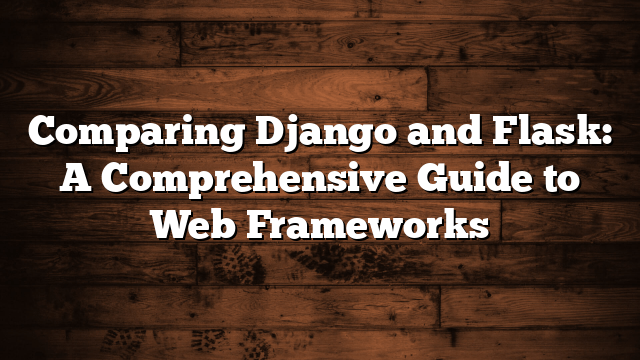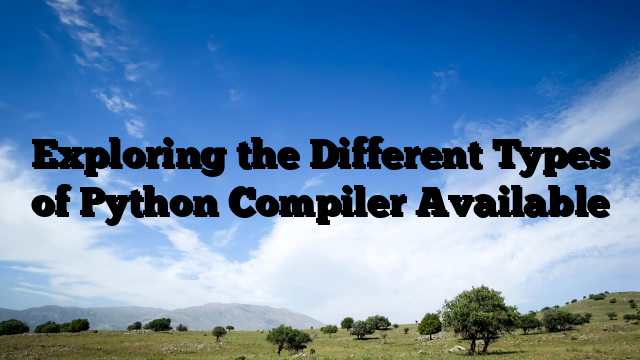- Get Started with Django: Python Web Framework
- django signals example
- Introdution to django signals post_save
- Mastering Django: A Comprehensive Guide to Web Development
- Building Dynamic Websites with Django: A Step-by-Step Tutorial
- Comparing Django and Flask: A Comprehensive Guide to Web Frameworks
Are you looking for a comprehensive guide to compare two of the most popular web frameworks – Django and Flask? This guide will provide an in-depth analysis of the features, benefits, and drawbacks of both frameworks, so you can make an informed decision about which one is best for your project. We’ll discuss the differences between Django and Flask, the pros and cons of each, and the best use cases for each framework. By the end of this guide, you’ll have a better understanding of which web framework is right for you.
Overview of Django and Flask
Django and Flask are two of the most popular web frameworks for Python. They are both open-source and have been around for a while, so they have a lot of community support and a large number of users.
Django is a full-stack web framework, meaning it has all the tools and libraries needed to create a complete web application. It is built on the Model-View-Controller (MVC) architecture, which makes it easy to separate the data layer from the presentation layer. It also has a built-in object-relational mapper (ORM) that simplifies database operations. Django is great for rapid development, as it comes with a lot of built-in features such as authentication, an admin interface, and a templating system.
Flask is a microframework, meaning it is a lightweight framework that provides only the basic tools needed to create a web application. It is built on the Werkzeug WSGI toolkit and the Jinja2 template engine. Flask is great for small projects and for prototyping, as it is easy to set up and get started with. It is also highly extensible, so it can be used to create complex applications.
Both Django and Flask are great options for web development in Python. They both have their strengths and weaknesses, so it is important to consider your project requirements before deciding which one to use. Django is great for larger projects that require a lot of features, while Flask is better for smaller projects that need to be set up quickly.
Advantages and Disadvantages of Django and Flask
Django and Flask are two of the most popular web frameworks for Python. They are both open-source and have been around for many years. Both frameworks have their advantages and disadvantages, and it can be difficult to decide which one is best for your project.
Advantages of Django
Django is a full-stack web framework, meaning it provides a lot of features out of the box. It has a powerful ORM (Object Relational Mapper) which allows developers to easily interact with databases. It also has an extensive library of built-in features such as authentication, authorization, and templating. This makes it easy to quickly develop complex web applications. Additionally, Django has a large and active community, so it is easy to find help and resources when needed.
Disadvantages of Django
The main disadvantage of Django is that it can be difficult to learn. It has a steep learning curve and requires a lot of knowledge of Python and web development. Additionally, Django can be slow and inefficient when dealing with large amounts of data.
Advantages of Flask
Flask is a micro-framework, meaning it is lightweight and easy to learn. It is great for small projects and can be quickly set up and deployed. Additionally, Flask is highly customizable and allows developers to easily add features as needed. It also has a large and active community, so it is easy to find help and resources when needed.
Disadvantages of Flask
The main disadvantage of Flask is that it does not have as many features as Django. It does not have an ORM or built-in authentication and authorization features. Additionally, Flask can be difficult to scale and is not suitable for large projects. It also does not have as large of a community as Django, so it can be difficult to find help and resources when needed.
In conclusion, both Django and Flask have their advantages and disadvantages. It is important to consider the size and complexity of your project when deciding which framework to use. Django is great for large and complex projects, while Flask is better for small and simple projects.
Feature Comparison of Django and Flask
When it comes to choosing a web framework for your project, two of the most popular options are Django and Flask. Both are open-source frameworks that offer a wide range of features and capabilities. So how do you decide which one is right for you? Let’s take a look at a feature comparison of Django and Flask to help you make the best decision.
First, let’s look at the programming languages that each framework supports. Django is written in Python, while Flask is written in Python and JavaScript. This means that if you’re familiar with Python, Django may be the better choice for you. However, if you’re comfortable with both languages, then Flask may be the better option.
Next, let’s look at the database support that each framework offers. Django supports a wide range of databases, including PostgreSQL, MySQL, and SQLite. Flask, on the other hand, only supports SQLite. This means that if you’re looking for a framework that supports a wide range of databases, Django is the better choice.
When it comes to template support, Django offers a wide range of options, including HTML, XML, and JSON. Flask, on the other hand, only supports HTML. This means that if you’re looking for a framework that supports a wide range of templates, Django is the better choice.
Finally, let’s look at the scalability of each framework. Django is designed to be highly scalable, meaning that it can handle large amounts of traffic and data. Flask, on the other hand, is designed to be more lightweight and is better suited for smaller projects.
Overall, Django and Flask both offer a wide range of features and capabilities. The best choice for you will depend on your programming language preferences, database support needs, template support requirements, and scalability needs. Ultimately, the decision is yours to make.
Performance Comparison of Django and Flask
Django and Flask are two of the most popular web frameworks for Python. They both have their own advantages and disadvantages, and the choice of which one to use depends on the particular needs of the project. In this article, we will compare the performance of Django and Flask to help you decide which one is right for your project.
When it comes to performance, Django and Flask are both excellent choices. Both frameworks are built on top of the Python language, which is known for its speed and scalability. Django is a full-stack framework, meaning it comes with a lot of built-in features and tools that make it easier to develop complex web applications. Flask, on the other hand, is a microframework, meaning it is lightweight and only provides the basic features needed to build a web application.
In terms of raw performance, Django is the clear winner. It is optimized for speed and scalability, and it is able to handle large amounts of traffic with ease. It also has a built-in caching system that can help improve performance even further. Flask, on the other hand, is not as optimized for speed and scalability, but it is still able to handle large amounts of traffic.
When it comes to development time, Flask is the clear winner. It is much easier to set up and use than Django, and it requires less code to get a basic web application up and running. This makes it ideal for small projects or prototypes. Django, on the other hand, is more complex and requires more code to get a basic web application up and running.
Overall, both Django and Flask are excellent choices for web development. Django is the better choice for larger projects that require scalability and performance, while Flask is the better choice for smaller projects or prototypes. Ultimately, the choice of which one to use depends on the particular needs of the project.
Cost Comparison of Django and Flask
When it comes to web development, two of the most popular frameworks are Django and Flask. Both frameworks have their own advantages and disadvantages, and it can be difficult to decide which one is best for your project. One of the key considerations when making this decision is cost.
When it comes to cost, Django and Flask have different pricing models. Django is an open-source framework, meaning that it is free to use. Flask, on the other hand, is a commercial framework, meaning that it requires a license to use. The cost of a Flask license depends on the size of the project and the features you need. Generally speaking, Flask licenses can range from a few hundred dollars to several thousand dollars.
In addition to the cost of the framework itself, there are also costs associated with hosting and maintenance. Django is typically hosted on a cloud platform such as Amazon Web Services or Microsoft Azure, and the cost of hosting will depend on the size and complexity of the project. Flask is typically hosted on a dedicated server, and the cost of hosting will depend on the size and complexity of the project. Both frameworks also require regular maintenance and updates, which can add to the overall cost.
Overall, the cost of using Django or Flask will depend on the size and complexity of the project. Generally speaking, Django is a more cost-effective option for smaller projects, while Flask is better suited for larger projects. Ultimately, the best way to determine which framework is best for your project is to evaluate the cost and features of each option.
In conclusion, Django and Flask are both popular web frameworks that can be used to create powerful and dynamic web applications. While Django is a full-stack framework that provides a wide range of features and capabilities, Flask is a microframework that offers a minimalistic approach to web development. Ultimately, the choice between Django and Flask depends on the specific needs of the project. Both frameworks have their own advantages and disadvantages, and it is important to weigh the pros and cons before making a decision. With this comprehensive guide, you now have the knowledge to make an informed decision when comparing Django and Flask.


















